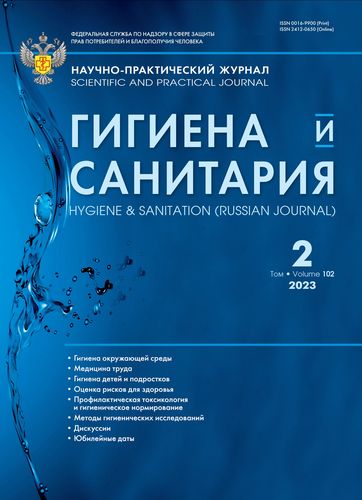Current concepts of the radio-biological effects of plutonium and uranium (Based on ICRP Publication 150)
- Authors: Parinov O.V.1, Semenova M.P.1, Shandala N.K.1, Lyaginskaya A.M.1, Metlyaev E.G.1, Kuptsov V.V.1, Bogdanov I.I.1
-
Affiliations:
- State Research Center — Burnasyan Federal Medical Biophysical Center of Federal Medical Biological Agency
- Issue: Vol 102, No 2 (2023)
- Pages: 175-180
- Section: HEALTH RISK ASSESSMENT
- Published: 25.03.2023
- URL: https://ruspoj.com/0016-9900/article/view/638617
- DOI: https://doi.org/10.47470/0016-9900-2023-102-2-175-180
- ID: 638617
Cite item
Full Text
Abstract
Introduction. The article discusses the health risks associated with exposure to plutonium and uranium, given in ICRP Publication 150 and relevant in the context of the development of technologies, the production of new types of nuclear fuel.
Cancer risk from plutonium exposure. Exposure to plutonium occurs predominantly in industrial settings. After inhalation and deposition in the respiratory tract, plutonium is eliminated by particle transport to the digestive tract and lymph nodes, and by absorption into the blood. The main risk associated with exposure to plutonium is lung cancer. Comparing the lifetime excess risk of mortality from lung cancer due to external gamma radiation (based on a lifetime survey of Japanese residents who survived the atomic bombing) and internal exposure to plutonium alpha particles (based on a study of Mayak employees), for the same absorbed dose to the lungs, the risk associated with exposure to plutonium alpha particles was found to be greater than the risk associated with external gamma exposure by about 15–16 and 19–22 times.
Cancer risk from exposure to uranium. At present, there is very little evidence to suggest a relationship between internal dose due to uranium exposure and cancer risk. ICRP Publication 150 provides a critical review of the UNSCEAR Report 2016 (2017) and discusses recent epidemiological studies. There are different health hazards at different stages of the nuclear fuel cycle, given the different forms of uranium present at each stage. Estimating doses from exposure to uranium for workers in the nuclear fuel cycle is difficult due to the relatively rapid elimination of uranium from the bloodstream, variability in exposure to uranium compounds, and differences in the methods used to control internal exposure. Based on published research data, it is not possible to quantify the risk of cancer from uranium by doses to individual organs/tissues.
Conclusion. Research was carried out as a part of the study of the properties of new types of nuclear fuel should take into account the comprehensive data presented in ICRP Publication 150.
Contribution:
Parinov O.V. — the concept and design of the study, the collection of material and data processing, statistical processing, writing the text, responsibility for the integrity of all parts of the article;
Semenova M.P. — collection of material and data processing, writing the text;
Shandala N.K. — editing, responsibility for the integrity of all parts of the article;
Lyaginskaya A.M., Metlyaev E.G., Kuptsov V.V., Bogdanov I.I. — collection of material and data processing, statistical processing.
All co-authors — approval of the final version of the article.
Conflict of interest. The authors declare no conflict of interest.
Acknowledgement. The study had no sponsorship.
Received: Augist 8, 2022 / Accepted: December 8, 2022 / Published: March 25, 2023
About the authors
Oleg V. Parinov
State Research Center — Burnasyan Federal Medical Biophysical Center of Federal Medical Biological Agency
Author for correspondence.
Email: noemail@neicon.ru
ORCID iD: 0000-0003-2370-170X
Russian Federation
Mariya P. Semenova
State Research Center — Burnasyan Federal Medical Biophysical Center of Federal Medical Biological Agency
Email: noemail@neicon.ru
ORCID iD: 0000-0003-0904-0415
Russian Federation
Natalya K. Shandala
State Research Center — Burnasyan Federal Medical Biophysical Center of Federal Medical Biological Agency
Email: noemail@neicon.ru
ORCID iD: 0000-0003-1290-3082
Russian Federation
Antonina M. Lyaginskaya
State Research Center — Burnasyan Federal Medical Biophysical Center of Federal Medical Biological Agency
Email: noemail@neicon.ru
ORCID iD: 0000-0003-2205-5670
Russian Federation
Evgeny G. Metlyaev
State Research Center — Burnasyan Federal Medical Biophysical Center of Federal Medical Biological Agency
Email: metlyaev@mail.ru
ORCID iD: 0000-0002-4578-8052
MD, PhD., Head of the Laboratory of public health monitoring of the State Research Center — Burnasyan Federal Medical Biophysical Center of Federal Medical Biological Agency, Moscow. 123098, Russian Federation.
e-mail: metlyaev@mail.ru
Russian FederationVladimir V. Kuptsov
State Research Center — Burnasyan Federal Medical Biophysical Center of Federal Medical Biological Agency
Email: noemail@neicon.ru
Russian Federation
Iliya I. Bogdanov
State Research Center — Burnasyan Federal Medical Biophysical Center of Federal Medical Biological Agency
Email: noemail@neicon.ru
ORCID iD: 0000-0002-1195-3515
Russian Federation
References
- Adamov E.O., Vlaskin G.N., Lopatkin A.V., Rachkov V.I., Khomyakov Yu.S. Radiation equivalent treatment of radioactive nuclides in nuclear fuel cycle – effective alternative to the delayed solution of spent nuclear fuel accumulation problem. Izvestiya akademii nauk. Energetika. 2015; (6): 15–25. (in Russian)
- Il’in L.A., Samoylov A.S., Tsov’yanov A.G., Shinkarev S.M., Shandala N.K., Gantsovskiy P.P., et al. Radiation-Hygienic Investigations оf Experimental Production оf Mixed Nitride Uranium-Plutonium Fuel at JSC Schc. Part 1: Methods and Results. Meditsinskaya radiologiya i radiatsionnaya bezopasnost’. 2021; 66(5): 23–32. https://doi.org/10.12737/1024-6177-2021-66-5-23-32 (in Russian)
- Il’in L.A., Samoylov A.S., Tsov’yanov A.G., Shinkarev S.M., Shandala N.K., Gantsovskiy P.P., et al. Radiation-Hygienic Investigations оf Experimental Production оf Mixed Nitride Uranium-Plutonium Fuel at JSC SChC. Part 2: Doses and Risks. Meditsinskaya radiologiya i radiatsionnaya bezopasnost’. 2022; 67(1): 39–45. https://doi.org/10.12737/1024-6177-2022-67-1-39-45 (in Russian)
- Parinov O.V., Lyaginskaya A.M., Shandala N.K., Metlyaev E.G., Kuptsov V.V. Problems of assessing the health status of personnel working in conditions of new technologies for nuclear fuel production. Meditsinskaya radiologiya i radiatsionnaya bezopasnost’. 2021; 66(3): 9–12. https://doi.org/10.12737/1024-6177-2021-66-3-9-12 (in Russian)
- ICRP Publication. Cancer risk from exposure to plutonium and uranium. Ann. ICRP. 2020; 50(4): 150.
- Zhukovskiy M.V., Kiselev S.M., Gubin A.T., eds. Lung Cancer Risk from Radon and Progeny and Statement on Radon [Risk vozniknoveniya raka legkogo pri obluchenii radonom i produktami ego raspada]. Moscow; 2013. (in Russian)
Supplementary files









